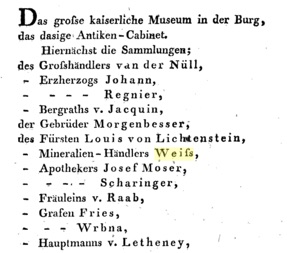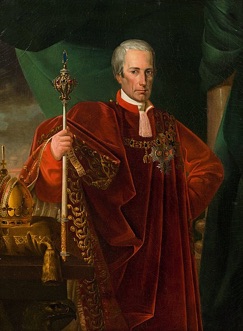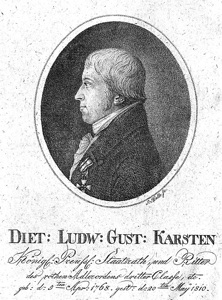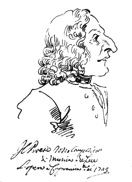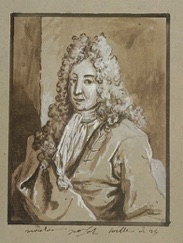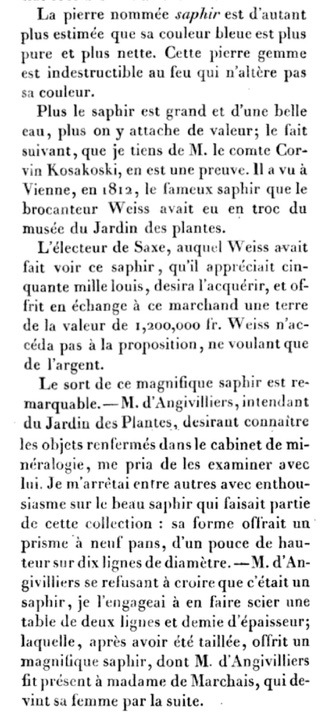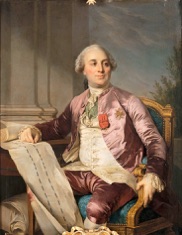The Weiss « COUP » (1802)



Haüy also enriched the mineral collection of the French MNHN.
Among others, in 1802, Haüy acquired an exceptional collection of 1650 minerals from Eastern Europe from an Austrian mineral dealer, "Mr. Weiss".
Louis-Nicolas Vauquelin
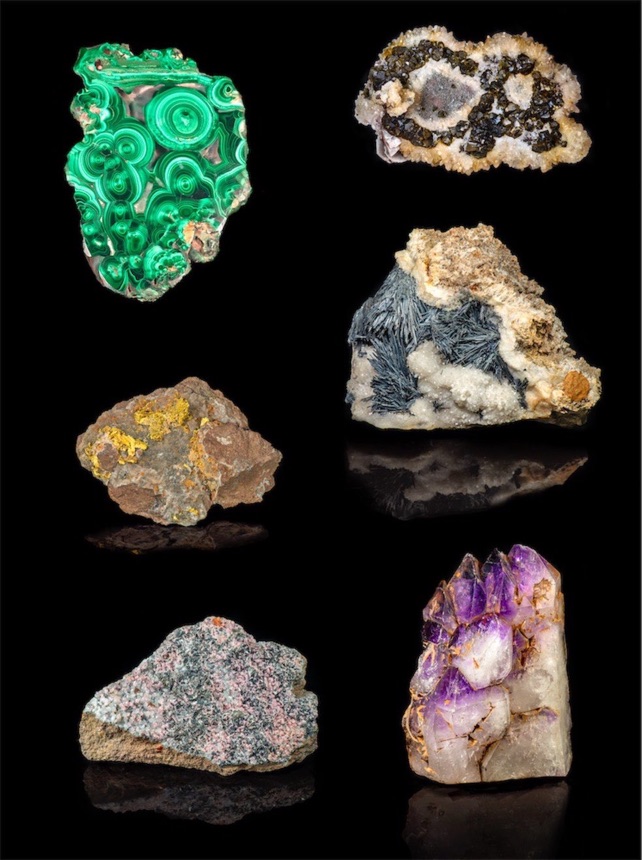
"Mr. Weiß" is an Austrian mineral dealer that is sometimes confused with the famous German mineralogist from Berlin, Christian Samuel Weiss (1780-1856).
Selection of minerals from Oriental Europe acquired by Haüy for the French MNHN in 1802-1804 to the Austrian mineral dealer Weiss with help from Napoléon Bonaparte ; (top to bottom, left to right) : malachite (Urals, Russia), sphalerite (Maramures, Romania) then crystallized native gold (Volea Rosie, Romania), stibnite (Baie Sprie, Romania) then naygyagite on rhodochrosite (Sacarimb, Romania) and amethyst (Nertschinsk, Russia). Scale bar is1 cm. MNHN, mineralogie. Photos: F. Farges.
According to the research of Pierre-Jacques Chiappero (MNHN), eight gems, including two large exceptionnal sapphires (302 and 163 carats !!!!), four rare colored diamonds (one blue, two pink and one green weighting together ca. 15 carats based on their values) and 165 other minerals were exchanged for these 1650 samples as well as a large gold nugget weighing 5,274 kg !
Some « doubles » specimens from the Museum that were exchanged with Weiss had later made their way to Austria and Germany. Indeed, German mineralogist Dietrich Ludwig Gustav Karsten (1768-1810) wrote in 1807 that he had acquired "a few years ago" a "strahliges Horners" (chlorargyrite) via Weiss, which could come from the "imperial cabinet" in Paris, i.e. from the Museum:

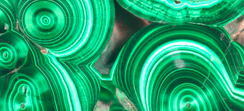
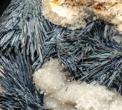
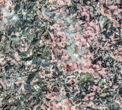
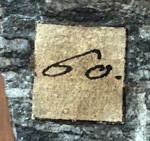
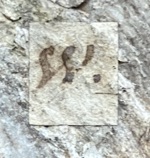
Only this sample still possess its original labels from the mineral dealer Weiss (W), sample # 60.
(courtesy P.J Chiappero)
MNHN, minéralogie.
Photos: F. Farges.
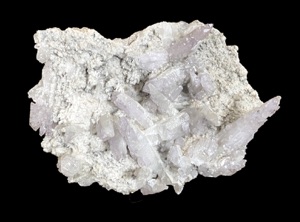
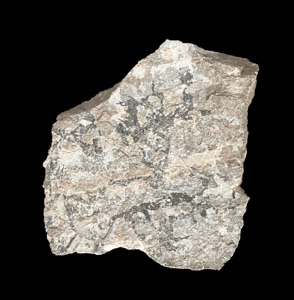
Sylvanite (Sigismond, Baia de Aries, Romania). Scale bar is 1 cm. MNHN, minéralogie. Photo : F. Farges.
Quartz amethysted (Banska Stiavnica, Czechia). Scale bar is 1 cm. MNHN, minéralogie. Photo : MNHN). Scale bar is 1 cm. MNHN, minéralogie. Photo: F. Farges.

THE GIFT FROM THE EMPEROR OF AUSTRIA (1815)

In 1815, the Emperor of Austria, Francis II (1768-1835) made an exceptional gift to Haüy of a second set of minerals from Central and Eastern Europe, which joined the collections of the MNHN.
Valentinite (Malack, Czechia). Scale bar is 1 cm. MNHN, minéralogie. Photo : MNHN). Scale bar is 1 cm. MNHN, minéralogie. Photo: MNHN
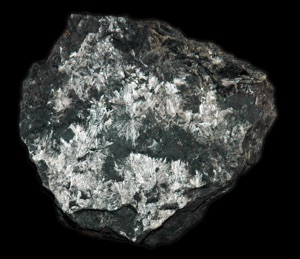
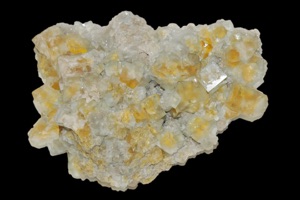
Calcédoine après fluorite
(Triesta, Romania). Scale bar is 1 cm. MNHN, minéralogie. Photo: MNHN
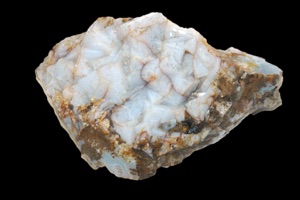
Fluorite (Annaberg, Saxony, Germany). Scale bar is 1 cm. MNHN, minéralogie. Photo: MNHN.



Leopold Kupelweiser : Emperor François II of Austria (1819). ©wikimedia
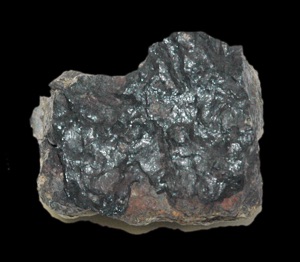
Pechblende (Jachymov, Czechia). Scale bar is 1 cm. MNHN, minéralogie. Photo: MNHN

Kermesite (Malacky, Czechia). Scale bar is 1 cm. MNHN, minéralogie. Photo : MNHN). Scale bar is 1 cm. MNHN, minéralogie. Photo: MNHN.
Agate (Saxe, Allemagne). Scale bar is 1 cm. MNHN, minéralogie. Photo: MNHN.
An European impact
Johann Samuel Ludwig Halle : Dietrich L. G. Karsten (avant 1810). ©wikimedia
This shows the prestige that the MNHN collection has gained under Haüy.
On this occasion, the emperor met the abbot-mineralogist when the coalition troops occupied Paris. It is said that the emperor spoke a lot to Haüy, which is reminiscent of the anecdote where the emperor Charles VI of the Holy Roman Empire spoke in 1728 to the abbot-composer Antonio Vivaldi (1678-1741) "the emperor talked to Vivaldi for a long time about music; it is said that he talked to him more in fifteen days than he talks to his ministers in two years...... "
More pieces exchanged with Mr. Weiss
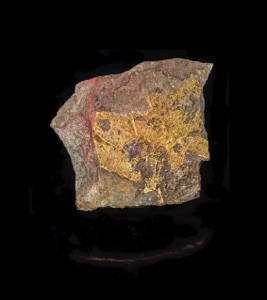

Native gold (« Verespatak », Roșia Montană, Romania). Sample and détail. Scale bar is 1 cm. MNHN, minéralogie. Photos: F. Farges.


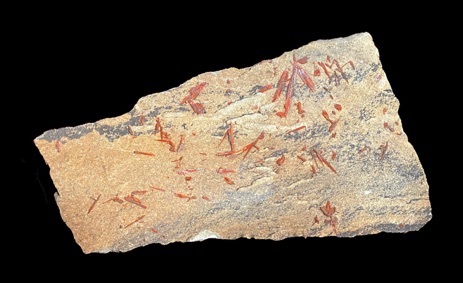
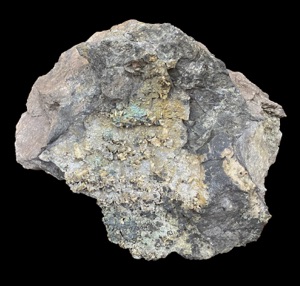
Crocoïte (Beresov, Russia). Scale bar is 1 cm. MNHN, minéralogie.
Photo: F. Farges.


Native gold (Valea Roșia Montană, Romania). Scale bar is 1 cm. MNHN, minéralogie. Photo: F. Farges.
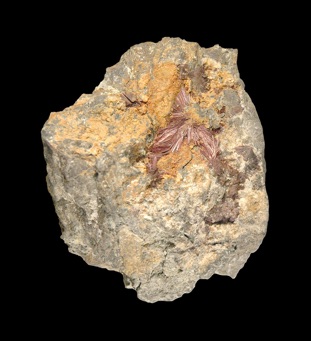
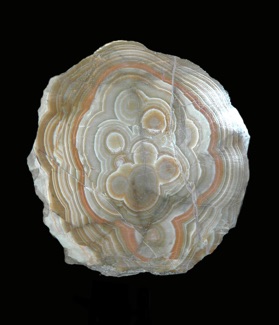


P.-L. Ghezzi : Vivaldi (1723) ©wikimedia
J.van Schuppen ; Charles VI (18th century). ©wikimedia
letter of abbot Conti to Madame de Caylus
Native gold on quartz (Zillerthal, Austria). Scale bar is 1 cm.
MNHN, minéralogie. Photo: F. Farges.
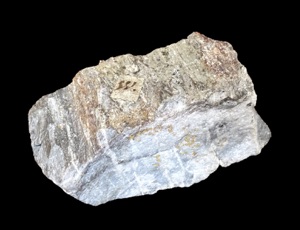

On the other hand, if the MNHN compensated the loss of the nugget by a recent purchase from Australia (inv. 201.2, weights 5 kg, shown right), the MNHN is not recovering from the loss of those four such large and exceptional fancy diamonds because, even today, the collection has only five "large" diamonds (10-330 cts), none of which are blue, pink, or green.
The values of these lost diamonds, including scientifically, exceeds infinitely those annotated in 1802, not much more than today’s 250,000 euros! (in constant euros, they would be worth about 100 times more).

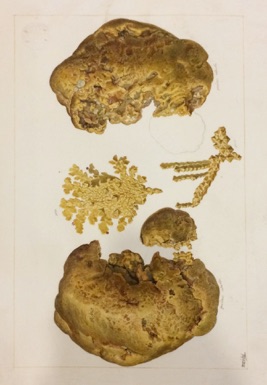
In 2014, I found a vellum in the Bibliothèque Centrale du MNHN that Pierre-Jacques Chiappero instantly identified as that of this nugget, in the hand of Nicolas Maréchal (1725-1802).
I reconstructed the nugget of Pajot in 3D: the 2 drawings overlap quite well (opposite) when one is turned over. If the vellum is life-size, as it should be, and, considering the remaining piece of known dimensions, it is possible to extrapolate an approximate volume: 8,8 x 7 x 3,3 cm.
According to Pierre-Jacques’ forthcoming research, this 5,2+ kg native gold nugget came from "Peru" (understand Viceroyalty of New Spain). It was given to the French Academy of Sciences by Louis-Léon Pajot, Earl of Ons-en-Bray (1678-1754) with his important naturalist and mechanical collections, but on condition that they be preserved...


Jean-Baptiste Oudry : portrait (undated) of monsieur Pajot. Paris, Louvre Museum.
Weiss probably melt it down unless it still exists in some collection, without its provenance...
Pierre-Jacques also found the detached piece shown on the vellum (red arrows above): it is inventoried 65.49, contains quartz fragments, weighs 352.5 g: a precise scale is thus obtained for the most "nugget of the Académie" that I prefer to rename "nugget of Pajot", its effective donor which legacy was not legally respected.
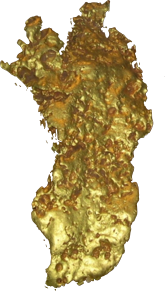
The value of this exchange is estimated at 150,000 francs at the time (incl. 89 000 for the 4 diamonds...).
THE « GOLD NUGGET
OF THE Académie »
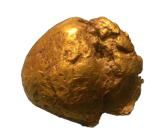
gold nugget
inv. 65.49

Weiss wanted, for two sapphires of the French Crown Jewels ridiculously low sums of which 1 800 francs for the 4th sapphire, bicolour of more than 19 2/16 ancient Paris carats (19,6 ct), estimated 6 000 livres in 1791 :

Concerning the 4 diamonds, the one called "fleur de pêcher" (peach blossom, light pink) is finally estimated at 30 000 francs, that is to say an estimated value of 90 000 livres tournois of the Ancien Régime.
On the basis of the inventory of 1791, this diamond weighed around 18-20 carats (± 5 carats according to the gemological characteristics).
For the blue diamond estimated at 35,000 pounds, the weight is about 20 carats.
As for the "diamant rose" estimated at 18,000 francs, it was probably a more or less colorless, rose-cut diamond (and not pink) of about 20 carats.
The green diamond must have weighed a few carats.
Weiss therefore minimized by a factor of about 3 to build his dealer's margin.
Luckily, it will be removed from the transaction like the Great Sapphire of Louis XIV.
The 4th sapphire of the French Crown Jewels (19,6 ct) and 1791expertise (left). Photos: F. Farges. Paris, MNHN, minéralogie.
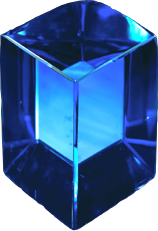
Grand Saphir of King Louis XIV of France, first sapphire of the French Crown Jewels (135,8 ct). Photo: F. Farges. Paris, MNHN, minéralogie.
These were very significant gems that were then lost, not to mention an exceptional sapphire that was lost, similar in value to the Grand Saphir above, and a beautiful emerald table reminiscent of the one still preserved, weighing about 17 carats:
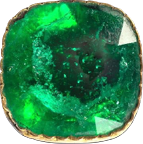

Emerald (ca. 17 ct, before 1823). Photo: F. Farges. Paris, MNHN, minéralogie.
Épilogue on these exchanges
When the sourpuss Balthazzar Sage (1740-1824) criticized "Abbé H." for this "barter", he called Weiss a "junk dealer": he cannot be entirely wrong, even if some beautiful minerals remain.
Julien Léopold Boilly : Balthazar Sage (1822). ©wikimedia/Wellcome
read Tableau comparé de la conduite... par Sage (1814) where Sage is angry against many...
In short, Sage criticizes "l'abbé H." but he had not done so well under the Ancien Régime with M. d’Angivillier, i.e. Charles-Claude Flahaut de la Billarderie, Earl of Angiviller (1730–1809) and his wife Elisabeth-Josèphe de Laborde (1725-1808) by sawing a 0.6 cm thick table on a 2.7 cm high crystal, i.e. a 20% reduction in an exceptional crystal just to identify it!

Personally, a "nine-sided prism" makes me think of indigolite rather than sapphire (is this Angivillier's doubt?): at that time, colored elbaite gem crystals, notably rubellite and indigolite, were highly prized, especially since a 6 mm thick sapphire must have been originally very dark to constitute the quality gem that was offered to Madame de Marchais. A lapidary search shows that it weighed about 26 carats in the rough and 18 carats in the cut, which makes it possible to refine the clarity of its color:
Concerning the beautiful sapphire exchanged to Weiss, estimated 50,000 louis (150,000 pounds) let the word to Sage :
This may explain the enormous value offered to Weiss for this crystal because, at that time, such a dark blue sapphire crystal would never have been worth so much. I calculated its sapphire weight: about 180 carats "rough", or 70 carats cut in the best case, or about 30,000 livres tournois (or francs) or 3,000 louis (maximum).
In indoglite equivalent, the crystal weighs 140 ct.
Clearly, Weiss knew he was getting a much better deal with an elbaite crystal "rough" because cut, it would have been too dark anyway (sapphire or elbaite). Especially since he seems to have been more of a mineral dealer than a gem dealer. Finally, I trust d'Angvillier, intendant of the King's Garden, more than Sage to identify a gem.


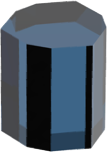
Photorealistic simulations (DiamCalc) based on the dimensions announced by Sage and using the same absorption spectrum of an indigolite from Brazil: (left) original crystal; (middle) slice sawn by Sage; (right) most obvious possible degree gem cut by d'Angivillier from Sage’s slice. Simulations: F. Farges.
18 ct
26 ct
140 ct
Joseph-Siffred Duplessis : portrait of the Comte d"Angiviller (1779). ©wikimedia/musée du Louvre.
His mineralogical cabinet was one of the most renowned in Vienna (1809 and 1834):
Johann Weiss was living in neue Wieden, in the south-west area of Wien (1806) :
"In Wien, there was once in the collection of the mineral dealer Weiß a brilliant beryl weighing 595 carats."
He was active between at least 1791 and 1812.
Johann Weiss lived since 1791 in Neue Wieden (SW of Vienna). he was also a collector of minerals then of gems (incl. these obtained from the MNHN in 1802). Jailed in 1808 (scam ?) as "mentally and physically ill", he died in Vienna in 1812 where he left a widow, Anna Weiss (-1816), and heirs.
"Pieces exchanged with Mr. Weiss"
The stone called sapphire is more valued because its blue color is purer and sharper. This gemstone is indestructible by fire, which does not alter its color.
The larger the sapphire and the more beautiful the water, the more value is attached to it; the following fact, which I have from Count Corvin Kosakoski, is proof of this. He saw in Vienna, in 1812, the famous sapphire that the dealer Weiss had got in barter from the museum of the Jardin des plantes.
The Elector of Saxony, to whom Weiss had shown this sapphire, which he valued at fifty thousand louis, wished to acquire it, and offered in exchange to this merchant a piece of land worth 1,200,000 fr. Weiss did not accede to the proposal, wanting only money.
The fate of this magnificent sapphire is remarkable. — M. d'Angivilliers, intendant of the Jardin des Plantes, wishing to know the objects contained in the mineralogy cabinet, asked me to examine them with him. I stopped among others with enthusiasm on the beautiful sapphire which was part of this collection: its form offered a prism with nine sides, of one [French] inch [= 2.7 cm] height on ten lignes [1 ligne = 2.2 mm] of diameter — Mr. d'Angivilliers refused to believe that it was a sapphire, so I asked him to have a table sawed two and a half lines thick, which, after being cut, gave a magnificent sapphire, of which Mr. d'Angivilliers made a present to Madame de Marchais, who later became his wife.
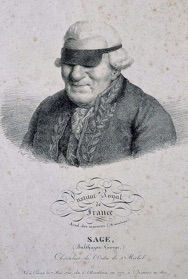


Haüy managed to acquire for the MNHN one of the most beautiful collections of minerals from Eastern Europe at that time. What wonders!
